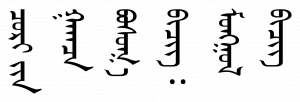Chapter 1: Human Language and Language Science
1.1 What even is language?
We’re all users of language. Right now I’m talking and writing to you in a variety of Canadian English, and I bet many of you also know one or more other languages. Linguistics is the scientific study of human language. That definition is short, but it’s not exactly simple, is it? How do we study language scientifically? And what even is language?
The word language is used for several different complex concepts that are interconnected with each other. One use of the word is to refer to individual languages, like American Sign Language (ASL), Basque, English, Langue des signes québecoise (LSQ), Nishnaabemwin, Xhosa, and many others.
For the moment, let’s think about one particular language, because it happens to be the one we’re using now. I’m using one variety of English (a variety spoken by a middle-aged white lady in Ontario). Before I started making this video, I used my fingers to type words on my keyboard. Now as I read those words and talk to you, I’m squeezing the air out of my lungs; I’m vibrating my vocal folds, and I’m manipulating parts of my mouth to produce sounds. Those sounds are getting captured by a microphone and recorded on my computer, then I’ll upload them to the eBook. If you’re listening to this video, the sounds I recorded are playing on your device, and your eardrums are reacting to the auditory information. If you’re reading the text or the captions, your eyes are reacting to the visual information. Your eyes and your ears send signals to your brain. And somehow, after all that, if my communication was successful, you end up with an idea in your mind that’s similar to the idea in mine. There must be something that we have in common to allow that to happen: some shared system that allows us to understand each other’s ideas through language. This shared system is what many linguists call the mental grammar, and one of the goals of linguistics is to find out what that shared system is like.
So we’ve focused our definition of linguistics a little bit, by saying that we’re interested in the scientific study of human language, of the grammar, the shared system that allows us to understand each other. What is the grammar like? Or to put it another way, what do we know when we know a language?
What is grammar?
Imagine you’re an alien, you’ve just arrived on Earth, and you need to figure out how to understand the language used in the particular earthling community that you’ve landed in. What kinds of things do you need to figure out? One of the first things you’ll need to know about that language is what counts as talking. Is this language signed or vocalized? In other words, what is the modality of the language? Many human languages are vocalized (or “spoken”). In this modality, language users make sounds with their larynx, tongue, teeth and lips, and receive sounds with their ears. Other human languages are signed. Language users make signs with their fingers, hands, wrists and forearms, and receive signs by sight or by touch. Even though they have very different modalities, sign and vocal languages share many properties in their grammars. In this book, we’ll try to reserve the words speaking and speech for vocal languages, and refer to language users when we’re talking about languages of any modality. In other places you might also see languaging used as a verb to mean “using language in any modality”.

Once you’ve figured out the modality, what next? You probably need to segment the stream of auditory or visual information into meaningful units. By observing carefully, you might be able to figure out that a particular sequence of sounds or gestures recurs in this language, and that some consistent meaning is associated with that sequence. For example, maybe you’ve noticed that the language users you’ve encountered make the sounds “cookie” as they’re offering you a round, sweet, delicious baked good. Or maybe you’ve noticed that when that word has a z sound at the end of it, cookies, you’re being offered more than one of them!
The part of the grammar that links up these forms with meanings is the mental lexicon. It’s a bit like a dictionary in your mind. Knowing a word in a language involves recognizing its form – the combination of signs or sounds or written symbols, and its meaning. For the majority of words in the world’s languages, the link between form and meaning is arbitrary.

For example, the English word for this thing is pumpkin and the Nishnaabemwin word is kosmaan. There’s nothing inherently orange or round or vegetabley about either of those word forms: the pairing of that meaning to that form is arbitrary in each language. (But there are words whose form has an iconic, less arbitrary relationship their meaning; we talk about them more later in this book.)
Suppose you’ve figured out that cookies are delicious and you want to ask your earthling hosts for more of them. To do that, you need to figure out how to control the muscles of your mouth, tongue, and lips to speak the word for cookie, or how to use your hands, fingers, wrists and forearms to sign the word. In other words, you need to know something about the articulatory phonetics of the language. This brings up an important point about grammar: when we know a language fluently, a lot of our grammatical knowledge is unconscious, or implicit. For the languages that you know, your knowledge of the lexicon is probably fairly conscious or explicit, and probably also some of your knowledge about your language’s morphology: that’s the combinations of meaningful pieces inside words (like how if you want more than one cookie you say cookies with a z). But you’re probably not as conscious of things like how you use your articulators to make the sounds k or z.
Our implicit knowledge of language also includes phonology, information about how the physical units of language can be combined and how they change in different contexts. Syntax is the part of your mental grammar that knows how words can or can’t be combined to make phrases and sentences, much of which is implicit. Syntax works hand in hand with semantics to allow the grammar to calculate the meanings of these phrases. And the pragmatics part of the mental grammar can help you to know what meanings arise in different contexts. For example, “I have some news,” could be interpreted as good news or bad news depending on the context.
All of these things are parts of the grammar: the things we know when we know a language. But a lot of this knowledge is implicit, and the thing about implicit knowledge is that it’s hard to observe. One of the most important jobs we’re doing in this textbook is trying to be explicit about what mental grammar is like, and about what kinds of evidence we can use to figure that out. We’ll talk about this challenge more in Section 1.3 below.
What about reading and writing?
I bet you’re wondering why I didn’t include reading and writing as part of the mental grammar above. After all, as a student you probably invested a lot of time into learning how to read and write. And those skills are indeed part of the grammatical knowledge you have about your language. But language users don’t actually need to know how to read and write to have a mental grammar. It’s common for kids in Canada to start learning to read and write around age five, but they are pretty competent in the phonetics, phonology, morphology, syntax and semantics of one or more languages before they ever go to school.


Furthermore, language users could start using a different writing system without changing anything else about the grammar. Mongolian, for example, presently uses two different writing systems: the Cyrillic alphabet and traditional Mongolian script, which is written vertically. Speakers of Mongolian understand each other’s speech no matter which script they use to record the language in writing. And there are plenty of human languages that just don’t have written forms. Signed languages like ASL and LSQ, for example, don’t have written forms. Most signers are bilingual in their sign language and in the written form of another language.
So, because not every human language has a reading and writing system and not every language user has access to reading and writing systems, we consider these skills to be secondary parts of the mental grammar. If you’re literate in your language, then that literacy is certainly woven into your mental grammar. But literacy isn’t necessary for grammatical competence.

